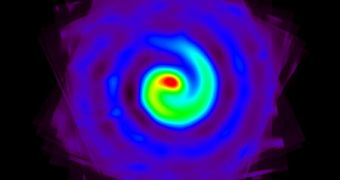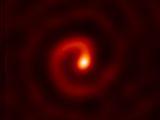It would certainly appear so, and considering that our galaxy is filled with at least 200 billion stars, it would be no surprise if one of these rays of death would decide to hit our planet some day. However, the subject of discussion here is a star dubbed WR104, located about 8,000 light years from Earth in the Sagittarius constellation. It was discovered eight years ago by an Australian astronomer at Sydney University, namely Peter Tuthill.
The WR104's spinning axis is pointing right towards Earth, not only that, but as the WR notation suggest - Wolf-Rayet - that the star is currently in its final supernova stage and could spray our planet with deadly showers of gamma-ray radiation any time.
WR104 is in fact a binary system, viewed from our perspective as a rotating pinwheel. The two stars orbit each other in the center of the massive structure, interacting through gravitational fields, which pull in the process massive amounts of hot gas, carbon and dust into interstellar space. Images provided by the Mauna Kea telescope in Hawaii reveal that this process is taking place roughly every eight months or so, laying out a perfect spiral structure as viewed from Earth.
Due to the unique positioning in space, we are able to view the system right from the top of its spinning axis, but this also puts our planet in grave danger. According to Tuthill, if one of the stars in our vicinity, having a similar configuration in relation to our planet, would decide to go nova, then there would be a relatively high chance that the gamma-ray burst emitted in the processes be concentrated in a narrow beam right towards the Earth.
Gamma-ray emissions are the most powerful type of electromagnetic radiation in the universe. Even with the massive distances between stars and a short gamma-ray burst, the Earth's ozone layer could be destroyed in an instant, leaving the planet totally unprotected from radiations emitted by the Sun and interstellar space. 99 percent of the species currently living on Earth would most likely go extinct. A similar theory could explain the mass extinction which took place about 443 million years ago during the Ordovician period.
Tuthill, on the other hand, appeals to calm. There are still uncertainties in the tilt of the spinning axis of the system, which means that Earth might still have a small chance that it is not in the direction of the eventual gamma-ray burst. Secondly, even though WR104 is in the final supernova stage, it could still take up to a few hundred thousand years before the star actually explodes.

 14 DAY TRIAL //
14 DAY TRIAL // 
